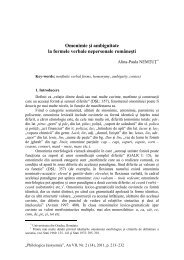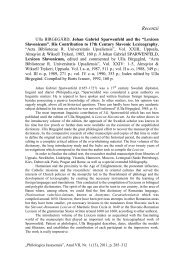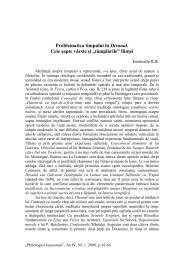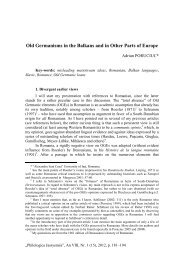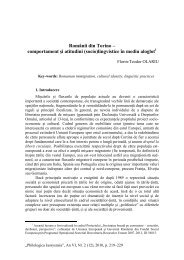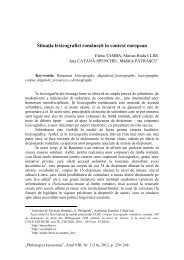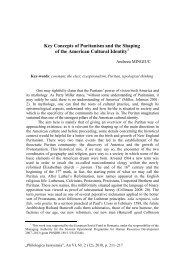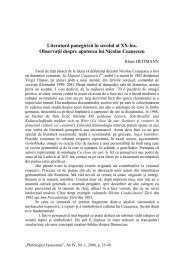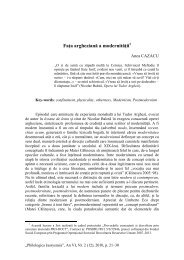Surrealism and The Feminine Element: André Breton's Nadja and ...
Surrealism and The Feminine Element: André Breton's Nadja and ...
Surrealism and The Feminine Element: André Breton's Nadja and ...
Create successful ePaper yourself
Turn your PDF publications into a flip-book with our unique Google optimized e-Paper software.
Ileana Alex<strong>and</strong>ra ORLICH<br />
_______________________________________________________________________________________________________________________________________________________________________________________________<br />
More importantly, whereas Naum makes Zenobia the sine qua non of his artistic<br />
inspiration who enables him to accede to an ever higher reality, Breton turns <strong>Nadja</strong>’s<br />
pursuits of enigmas <strong>and</strong> revelations into a sinister endeavor. Whereas Zenobia moves<br />
<strong>and</strong> deepens Naum’s imagination not so much as an object of carnal temptation but<br />
rather as a power that stimulates his expansion of consciousness, <strong>Nadja</strong> appears as a<br />
solitary figure, a satanic <strong>and</strong> self-sufficient angel aspiring to an infinite series of<br />
metamorphoses. She wonders what role she would have played at the time of Marie-<br />
Antoinette; appears as a voyante who sees the city lights transformed into a flaming<br />
h<strong>and</strong> <strong>and</strong> senses during a walk with Breton that a key episode of Poisson soluble took<br />
place at a specific spot; <strong>and</strong> ultimately becomes for Breton something of a witch closely<br />
associated with the devil, as evidenced in her drawing “<strong>The</strong> Devil’s Salute” <strong>and</strong> in<br />
“assuming with an astonishing facility the arrogance of the Devil [when] she has thrown<br />
a fold of her cape back over her shoulder” (102).<br />
As Xavière Gauthier points out in her book <strong>Surrealism</strong>e <strong>and</strong> sexuality, Breton’s<br />
views concerning women <strong>and</strong> the entire surrealist project are in fact determined by a<br />
fundamental contradiction within the general surrealist vision of femininity. Contained<br />
within Breton’s simultaneous exaltation of the supreme lover <strong>and</strong> his pleas for the<br />
unleashing of a completely unimpeded sexuality, such contradiction leads to both the<br />
sanctification of woman <strong>and</strong> to fear <strong>and</strong> debasement of her. While considering the<br />
opposites <strong>and</strong> extremes that color the portrayal of <strong>Nadja</strong>, Gauthier comments that Breton<br />
sees her as “edible, but she devours men; she is angel <strong>and</strong> demon, fairy <strong>and</strong> sorceress,<br />
salvation <strong>and</strong> damnation, symbol of purity as well as sin; she is singular <strong>and</strong> multiple,<br />
repose <strong>and</strong> turbulence, victim <strong>and</strong> executioner, nurturance <strong>and</strong> destruction, protector <strong>and</strong><br />
protected, giver of life <strong>and</strong> of death, mother <strong>and</strong> child, heaven <strong>and</strong> earth, vice <strong>and</strong> virtue,<br />
hope <strong>and</strong> despair, God <strong>and</strong> Satan” 13 .<br />
Unlike Breton’s vision, Naum’s predominant tendency with respect to Zenobia<br />
is toward sanctification, an attitude that seems to grow out of his insistence on the cult<br />
of supreme, monogamous love. Thus Naum’s love for Zenobia acquires something of a<br />
mystical or divine quality, closer to Breton’s view of woman in Arcane 17. As the<br />
satisfaction of a lifetime quest, it is an ultimate experience; their complete physical <strong>and</strong><br />
spiritual likeness leads to their being able to find each other in a specific movie theatre<br />
of a big city like Bucharest, based on the vague indication which Zenobia leaves for<br />
Naum that she expects him to join her at the movies because she has bought tickets.<br />
Breton’s experience with <strong>Nadja</strong>, which, as Michel Beaujour notes, “ultimately<br />
fails in that he cannot love or truly underst<strong>and</strong> her” 14 , requires further examination,<br />
particularly since such an exploration can highlight the differences between Breton’s<br />
<strong>and</strong> Naum’s ultimate objectives. From the beginning of their relationship, <strong>Nadja</strong> is not<br />
reassuringly reflective of Breton; instead, she goes off into new modes of “different”<br />
behavior clearly not prescribed by the masculine norm. Whereas Zenobia blends into<br />
Naum body <strong>and</strong> soul as his missing half of the reconstituted <strong>and</strong>rogyne, <strong>Nadja</strong> becomes<br />
quite literally incomprehensible, <strong>and</strong> therefore “mad.”<br />
<strong>The</strong> moment of <strong>Nadja</strong>’s final estrangement from Breton, as Bethany Ladimer<br />
remarks in her interesting discussion of <strong>Nadja</strong>, is rarely mentioned by critics of the work<br />
13<br />
Xavière Gauthier, <strong>Surrealism</strong> <strong>and</strong> Sexuality, Paris, 1971.<br />
14<br />
“French Studies”, XX (1966), 366-387.<br />
220



